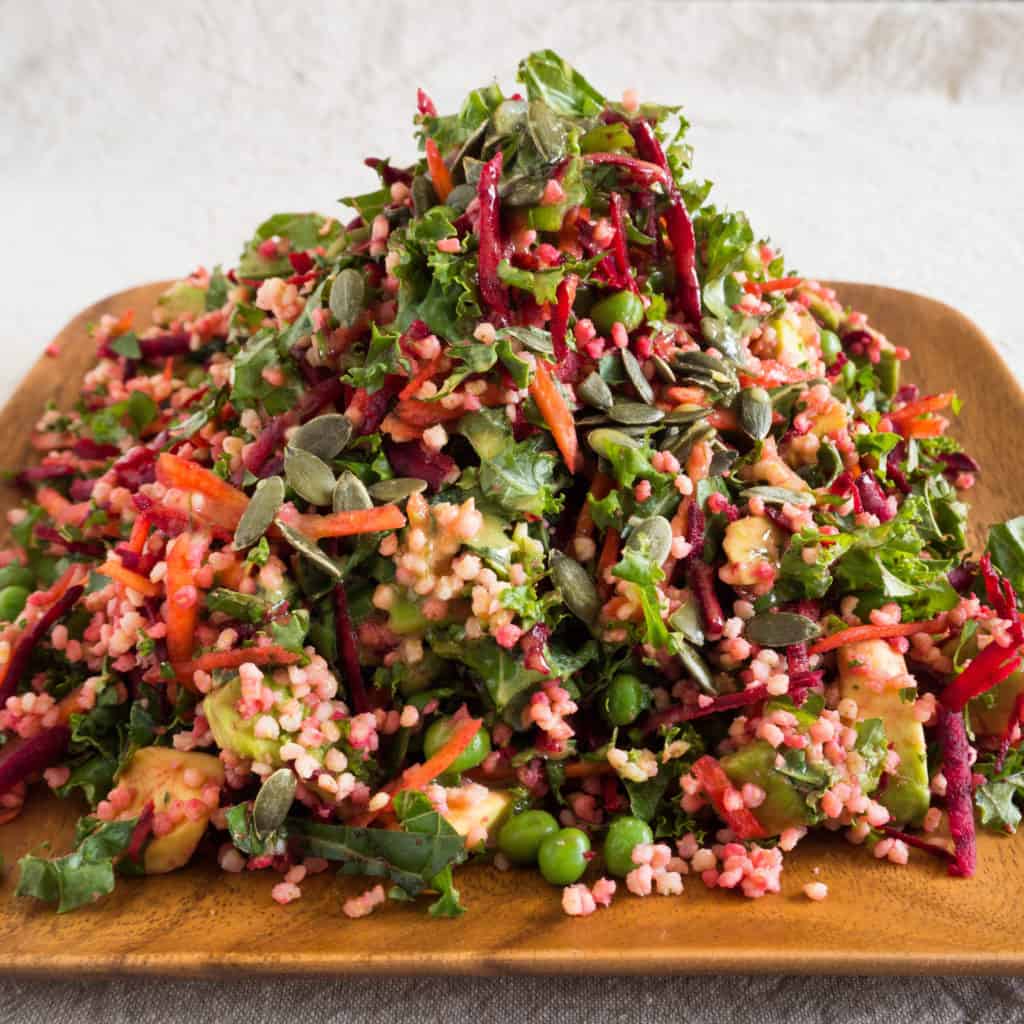
It’s the height of summer, you want something that tastes delicious, is light, healthy and nutritious and that something is Beetroot and Millet Mega-Salad. Beetroot is such an amazing ingredient: raw beetroot tastes as good, if not better, than cooked however, both are amazing; I love the colour and the way it stains everything; I love the taste, the deep earthiness; I also love the way it is a fantastic partner to so many foods. Add millet as a solid base and more colourful, crunchy vegetables and a superb dressing and you have a wonderful summer meal. This is a meal I first had many years ago with my now husband it was simple, perfect for the weather and perfect for us.
Find the full Beetroot and Millet Mega-Salad here.
If you just want perfect millet you will find my Basics – Perfect Millet recipe useful too.
This recipe uses raw kale. You can also use any other leafy green vegetable such as rocket, spinach, lettuce etc. or a mixture. I like the richness of kale with the sweetness of the beetroot.
You can use a mandolin to get super thin slices of beetroot – or grate it. Both are good.
Preparation
Difficulty easy
Preparation time 20 minutes
Cooking time 5 minutes
Find the full Beetroot and Millet Mega-Salad here.
Allergens
Beetroot and Millet Mega-Salad is gluten-free, vegan as well as…
Celery free
Coconut free
Garlic free
Lupin free
Nightshade free
Onion free
Peanut free
Sesame free
Soya free
Tree nut free
About
I have already extolled the virtues of Millet in my post here. But I have not really banged on about the wonders of raw beetroot (not too much anyway!).
Wonderful beetroot (AKA beets, table beet, garden beet, red beet, golden beet etc.) is the taproot of the beetroot plant. Beetroot is one of a number of cultivated varieties of beta vulgaris: grown for their edible taproots and their leaves (beetroot leaves are also delicious!).
Raw beetroot is 88 % water, 10 % carbohydrates, 2 % protein, and less than 1 % fat. A 100 gram serving provides 43 kilo-calories. Raw beetroot is a rich source (27% of the RDA) of folate and a moderate source (16% RDA) of manganese. What’s not to like?
Beetroot can be eaten boiled, roasted, raw, pickled… However you choose (personally raw and pickled are my favourites). You can leave the skin on beetroot (which helps with some the of staining that happens when you handle raw beetroot). It has a strong enough flavour and appearance to be the star of a dish or be a great supporting side. Young beetroot leaves can be added raw to salads and adult leaves can be boiled, steamed or stir-fried – in a similar way to spinach which has a similar taste and texture.
In Eastern Europe, borscht (beetroot soup) is a popular dish. In Poland, Ukraine, Serbia and other parts of Eastern Europe beetroot is combined with horseradish to form varieties of salad or side and is traditionally used with cold cuts and sandwiches, but often also added to a meal consisting of meat and potatoes. In Indian cuisine, chopped, cooked, spiced beet is a common side dish. A large proportion of commercial production is processed into jarred boiled, sterilised beetroot or into pickles.
Beetroot and Carrot Juice is one of my favourite juices. I would drink it everyday if I could.
Beetroot is also used as a food colouring. Betanins are used industrially as red food colourants, e.g. to intensify the colour of tomato paste, sauces, desserts, jams and jellies, ice cream, sweets, and breakfast cereals.[7]
I have heard that beetroot can be used to make wine. I haven’t tried to make it, or drink it, but I would love too. I bet the colour is amazing…